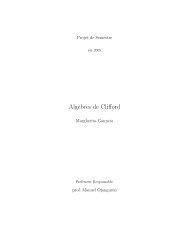Autour des Th´eor`emes d'Hurewicz - CQFD - EPFL
Autour des Th´eor`emes d'Hurewicz - CQFD - EPFL
Autour des Th´eor`emes d'Hurewicz - CQFD - EPFL
You also want an ePaper? Increase the reach of your titles
YUMPU automatically turns print PDFs into web optimized ePapers that Google loves.
24 2. LES GROUPES D’HOMOLOGIE D’UN ESPACE TOPOLOGIQUE<br />
THÉORÈME-DÉFINITION 2.16.<br />
Pour toute paire d’espaces (X, A) on a la suite en homologie associée<br />
. . .<br />
j ∗<br />
H q+1 (X, A)<br />
∂ ∗<br />
H q (A)<br />
i ∗<br />
H q (X)<br />
j ∗<br />
H q (X, A)<br />
∂ ∗<br />
. . . .<br />
Les applications i ∗ et j ∗ sont les applications induites par les injections i : A ↩→ X et<br />
j : (X, ∅) ↩→ (X, A). L’application ∂ ∗ : H q+1 (X, A) → H q (A) est donnée par ∂ ∗ ([z] (X,A) ) =<br />
[∂z] A .<br />
DÉMONSTRATION. On considère la courte suite<br />
0 S(A)<br />
i •<br />
S(X)<br />
j •<br />
S(X, A) 0 .<br />
Cette suite est exacte en S(A) et en S(X, A) car i • : S q (A) → S q (X) est injective<br />
et j • : S q (X) → S q (X, A) est surjective. De plus elle est exacte en S(X) puisque<br />
Im i • = S q (A) = Ker j • . On applique le lemme 1.18 pour obtenir la longue suite<br />
exacte en homologie qu’on cherche.<br />
□<br />
EXEMPLE 2.17.<br />
Si on prend une paire d’espaces (X, x 0 ) où x 0 ∈ X est un point, alors la longue suite<br />
exacte en homologie est<br />
. . .<br />
j ∗<br />
H q+1 (X, x 0 )<br />
∂ ∗<br />
0<br />
i ∗<br />
H q (X)<br />
j ∗<br />
<br />
H q (X, x 0 )<br />
∂ ∗<br />
0<br />
i ∗<br />
. . . .<br />
Parce que H q (x 0 ) = 0 pour q 0 d’après 2.10. Donc H q (X, x 0 ) H q (X) pour q 0.<br />
Pour n = 0 l’inclusion i ∗ : H 0 (x 0 ) → H 0 (X) est injective car H 0 (X) est un groupe<br />
abélien libre engendré par les classes [y k ] où chaque y k est dans une composante<br />
connexe de X. On a ainsi une courte suite exacte<br />
0 H 0 (x 0 )<br />
i ∗<br />
H 0 (X)<br />
j ∗<br />
H 0 (X, x 0 ) 0.<br />
3. Le théorème d’homotopie<br />
THÉORÈME 2.18.<br />
Soient f, g : X → Y deux fonctions continues. Si f ≃ g alors f ∗ = g ∗ : H q (X) → H q (Y).<br />
Pour faire la preuve de ce théorème très important il nous faut d’abord un<br />
lemme. On ne va pas prouver ce lemme ici. Une preuve complète se trouve sur la<br />
page 171 de [15].<br />
LEMME 2.19.<br />
Pour tout espace topologique X et pour tout entier q il existe un homomorphisme<br />
avec les propriétés suivantes :<br />
D X : S q (X) → S q+1 (X × I)


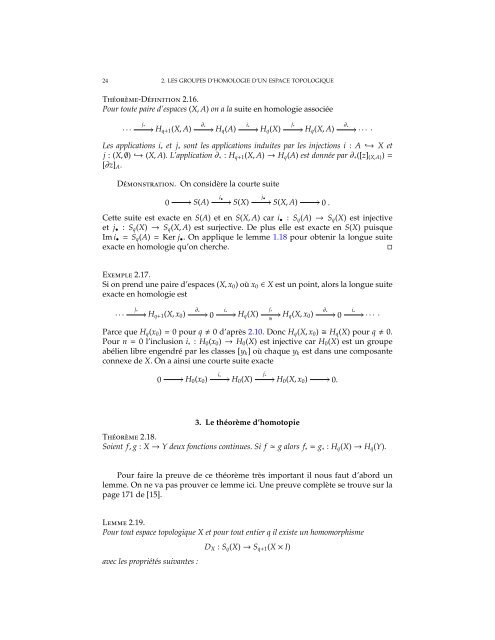
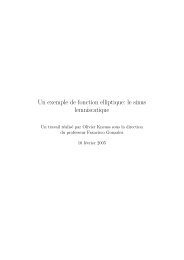
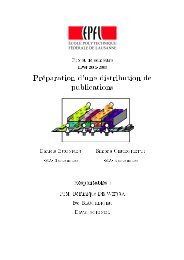

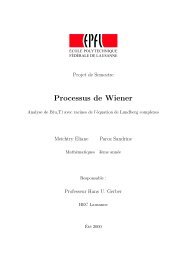
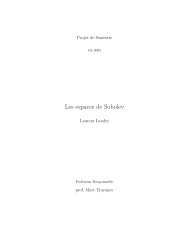
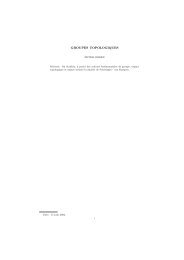
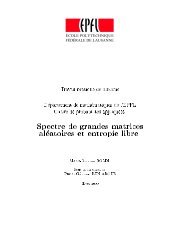
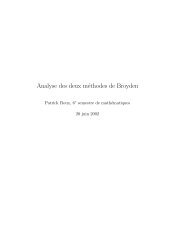
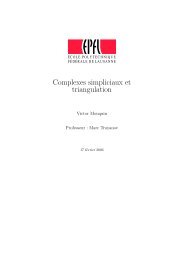
![Identification du dual topologique de C[a, b] Louis ... - CQFD - EPFL](https://img.yumpu.com/32808525/1/184x260/identification-du-dual-topologique-de-ca-b-louis-cqfd-epfl.jpg?quality=85)


